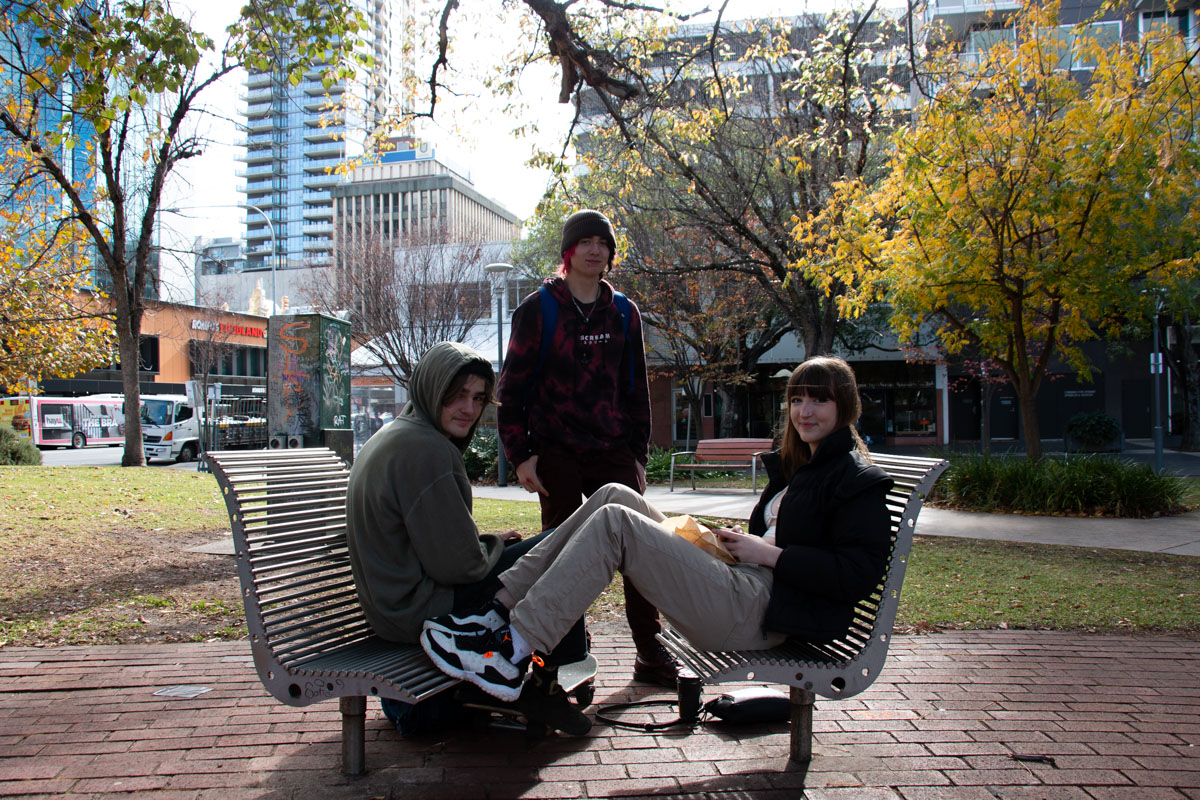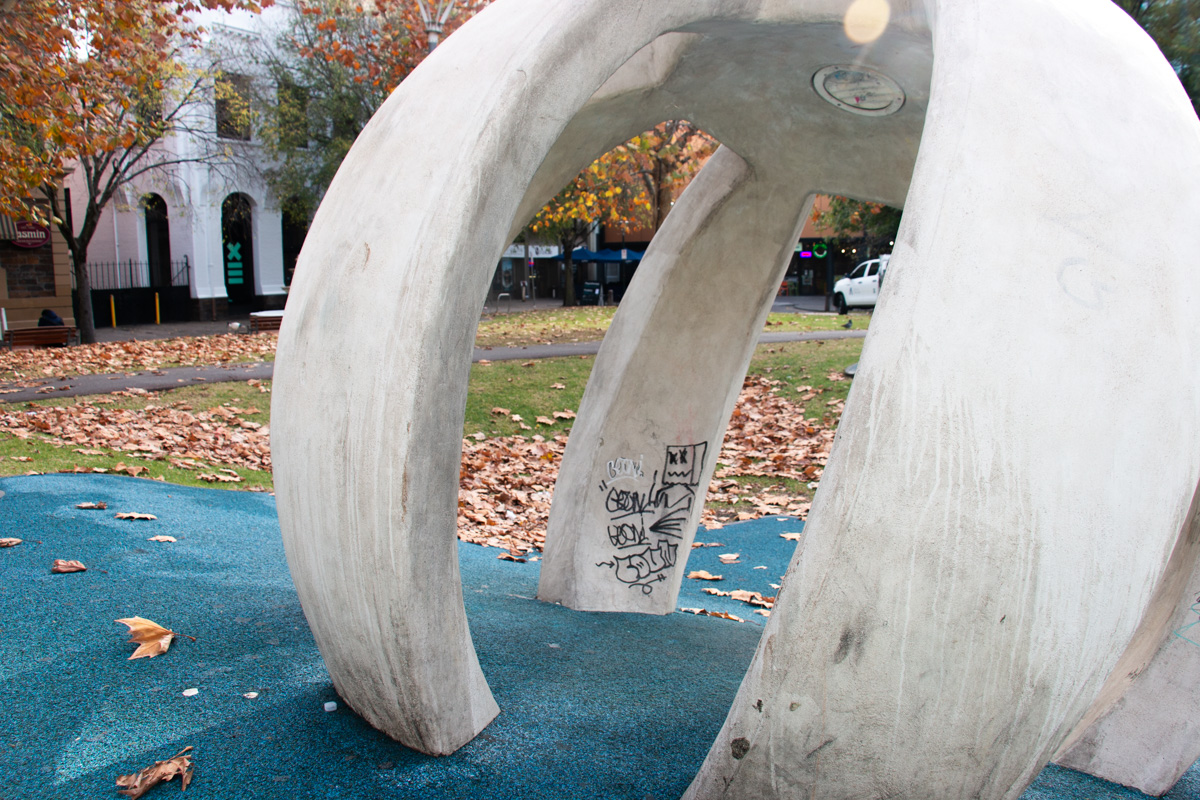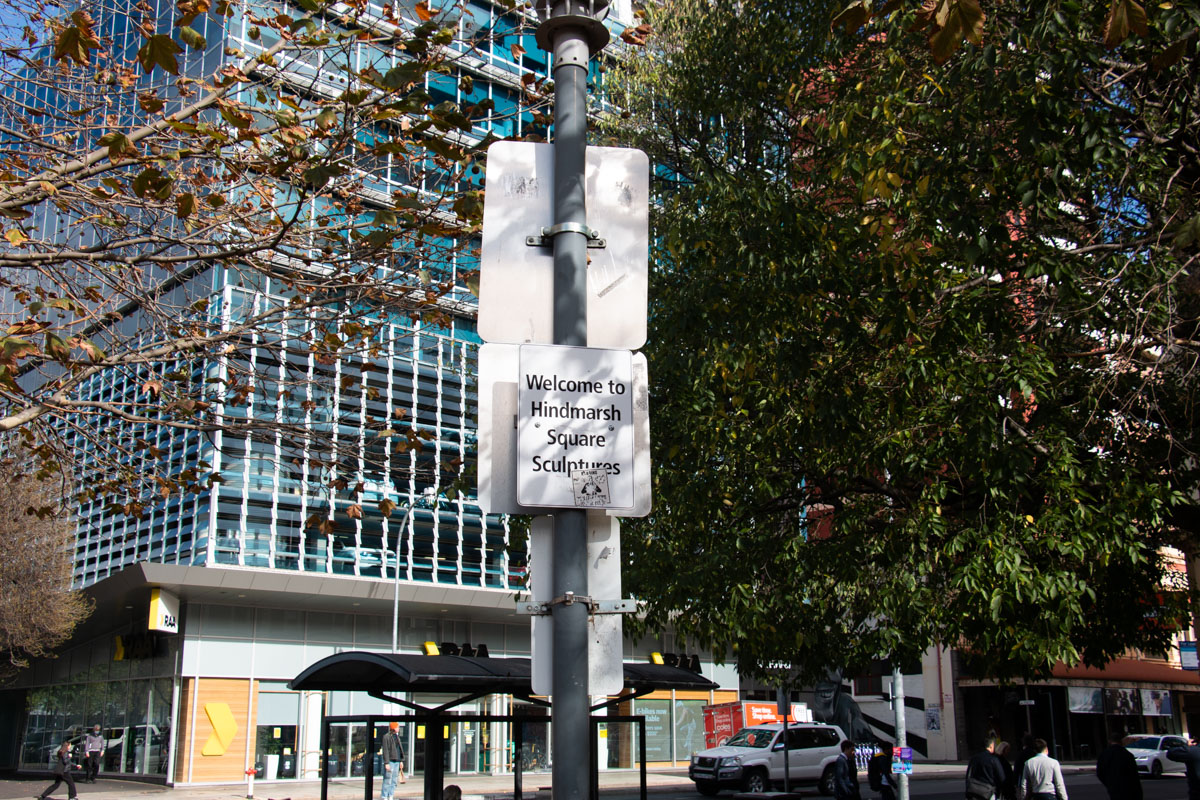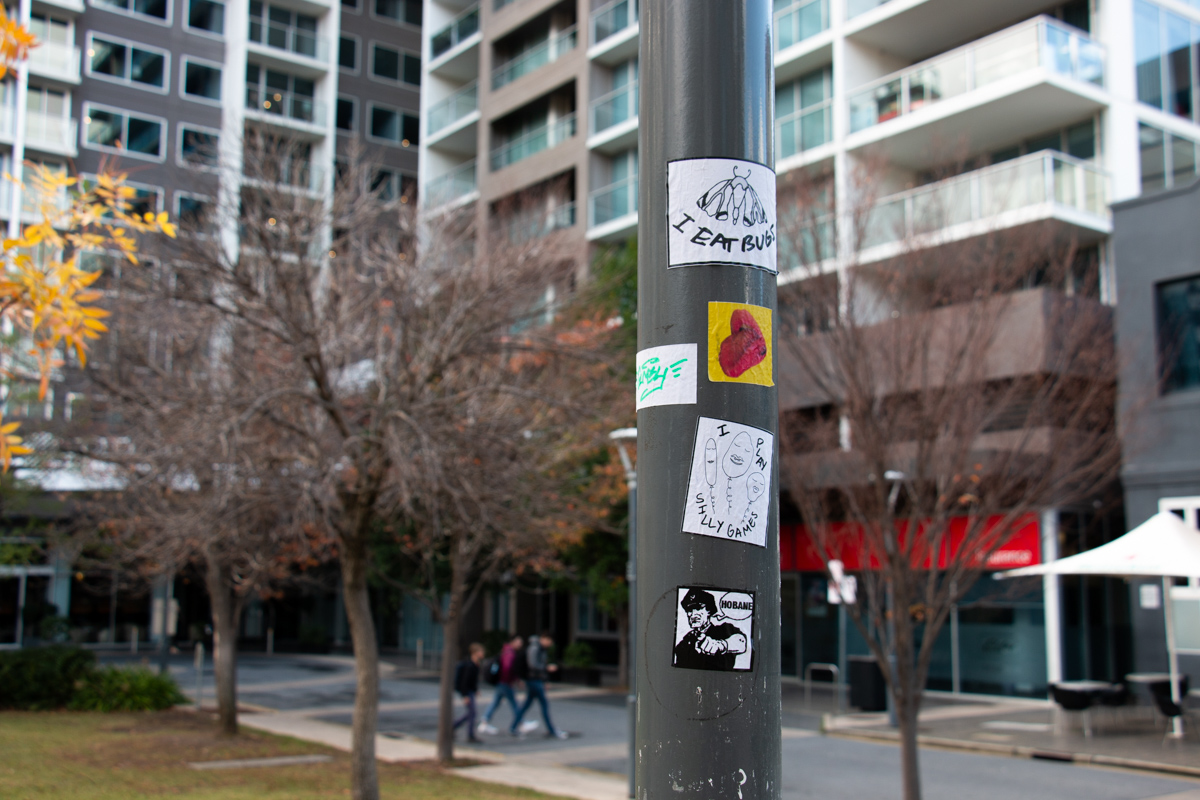The bleeding hearts of Emo Park
Words and pictures: Angela Skujins
Whether you belong to the subculture or not, everyone knows of Adelaide’s Emo Park. We spent some afternoons hanging out at the two inner-city parks that make up Adelaide’s Emo universe to get to know the regulars and their habits.
On a sunny afternoon in the north-east pocket of postcode 5000’s Mukata Hindmarsh Square, CityMag asks 18-year-old Miles and 17-year-old Jules*, two friends sitting cross-legged on the grass, to describe each other’s appearance.
Miles, a debonair young trans man with green hair and wearing a silk bomber jacket, says Jules, who identifies as non-binary, has “piercings everywhere”. (*We’ve given Jules a pseudonym to protect their identity.)

“Literally every piercing you can probably imagine. Except the eyebrow,” he says.
“You have, like, pinkish-red, like, in the roots, and then you’ve sort of got, like, the shag haircut going on, with, like, black through the rest of it. Blue eyes – gorgeous. Your fashion is very individualistic.”
It’s 2pm and there aren’t many people in the park. Just a couple of teenagers who look like they should be elsewhere. From their sheepish look, we assume they’re wagging – a practice this reporter knows well. (I routinely hid from bullies in high school toilet cubicles.)
As Miles continues the visual assessment, listing Jules’ purple “boho” hippie pants and their green fleece pullover, he doesn’t mention the wounds on Jules’ left hand – about five shallow cuts bleeding on the ridge of their knuckle. We ask about them.
“I have borderline personality disorder,” Jules explains, “which means I feel my emotions at like 200 per cent. So I just get really enraged really quickly and just punched up. That’s how that happened.
“Just another part of life.”

The official name of the park we’re in is Mukata Hindmarsh Square Playspace, but even the Adelaide Economic Development Agency is aware of its better known, if unofficial, moniker. The City of Adelaide subsidiary’s website refers to the site as Emo Park.
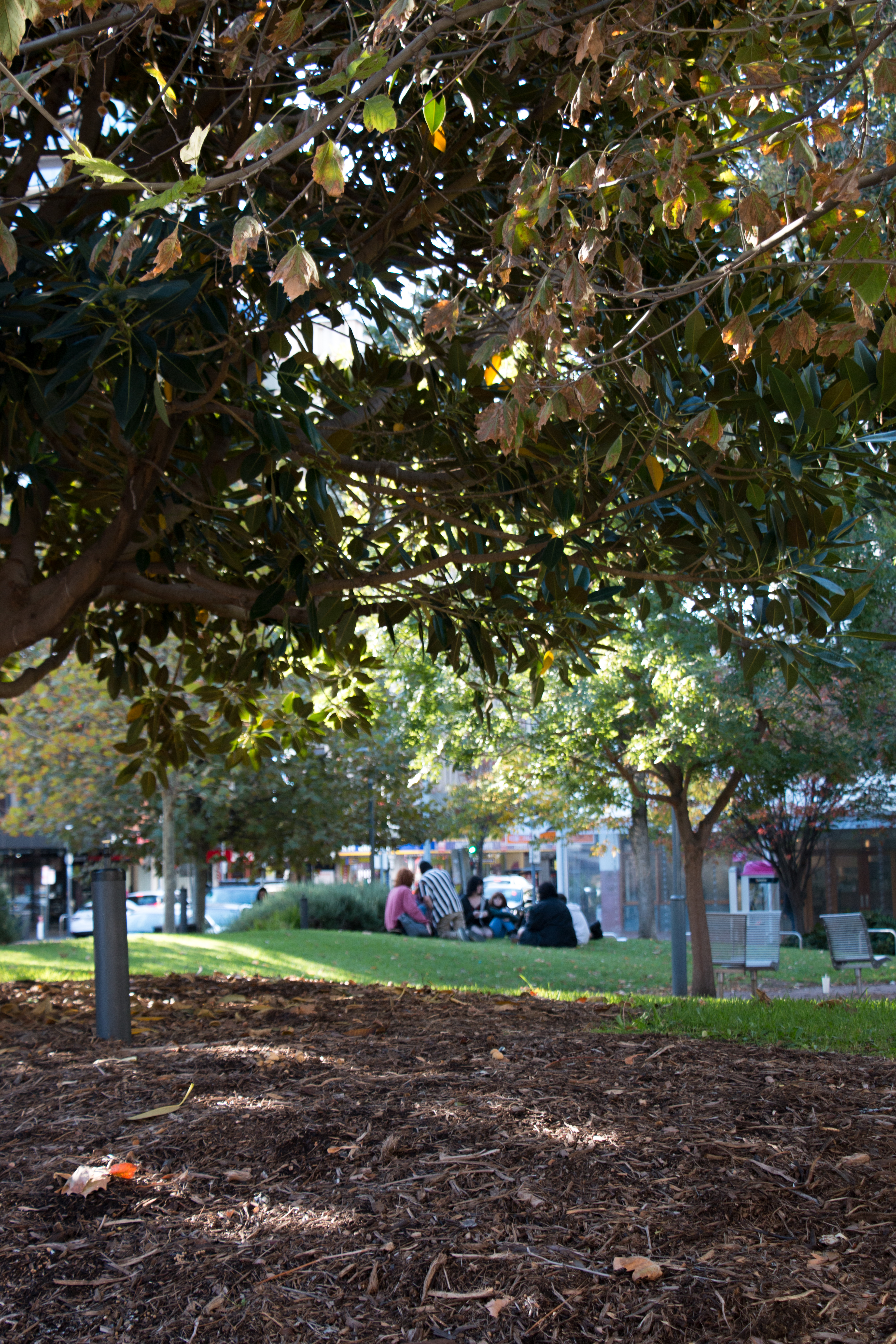
City of Adelaide’s director of city shaping, Ilia Houridis, says the council recognises placemaking can happen at a “grassroots level” and “Emo Park” is an “affectionate name that is not officially endorsed, but unofficially recognised by the City of Adelaide”.
According to the council website, it is a “popular place for city workers to relax during their lunch breaks”.
Emo Park is actually two opposing parks north of Grenfell Street. They make up half of the larger Mukata Hindmarsh Square area, which is split into quadrants by Grenfell and Pulteney streets.
The eastern side of Emo Park – where Jules and Miles hang out – is filled with single-person steel seats and trees. A monolithic granite structure, designed by Barossa Valley visual artist Paul Trappe and installed in the late ‘70s, stands at the back, facing the road.
On the day CityMag visits, young people gather near the giant sculpture. Many have dyed hair, piercings and wear grungy clothes. Fishnet stockings, oversized jumpers and big leather boots are in high use.
Natural wine bar LOC, second-hand clothing store Room on Fire and Dunfor Noodle Bar are in close proximity. The brightly coloured shops and eateries, bordering the park at ground level, juxtapose against the punters’ macabre clothes.

The much older Griffins Hotel pub is nearby, in the south-eastern corner, with the Pullman Adelaide Hotel beside it. Some of the kids throw up large vape plumes, do somersaults, and eat KFC on the autumn leaves. Nearby, gloved chauffeurs open polished car doors for arriving Pullman guests.
Over the road, the western side of Emo Park (known as the original Emo Park) has an uneven surface, with large sculptures jutting out from its undulating hills. There’s a big grey tap, hose, thong and fish skeleton, installed in 2007 by artists Ryan Sims, Gerry Wedd (who famously drew illustrations for Mambo) and landscape architect company Taylor Cullity Lethlean.
A building containing the State Government’s Department for Health and Wellbeing abuts this side of the park, near the city’s main shopping precinct, Rundle Mall. There is also the local cult music shop Derringers nearby.
South of Grenfell Street, Mukata Hindmarsh Square is a different picture. There are long stretches of green grass and patches of colourful flowers. White-collar office workers can often be found there, enjoying the fresh air on their lunch breaks. This half of the park has no obvious draw on the alternative young people – those with the dyed hair, dark clothing and piercings.
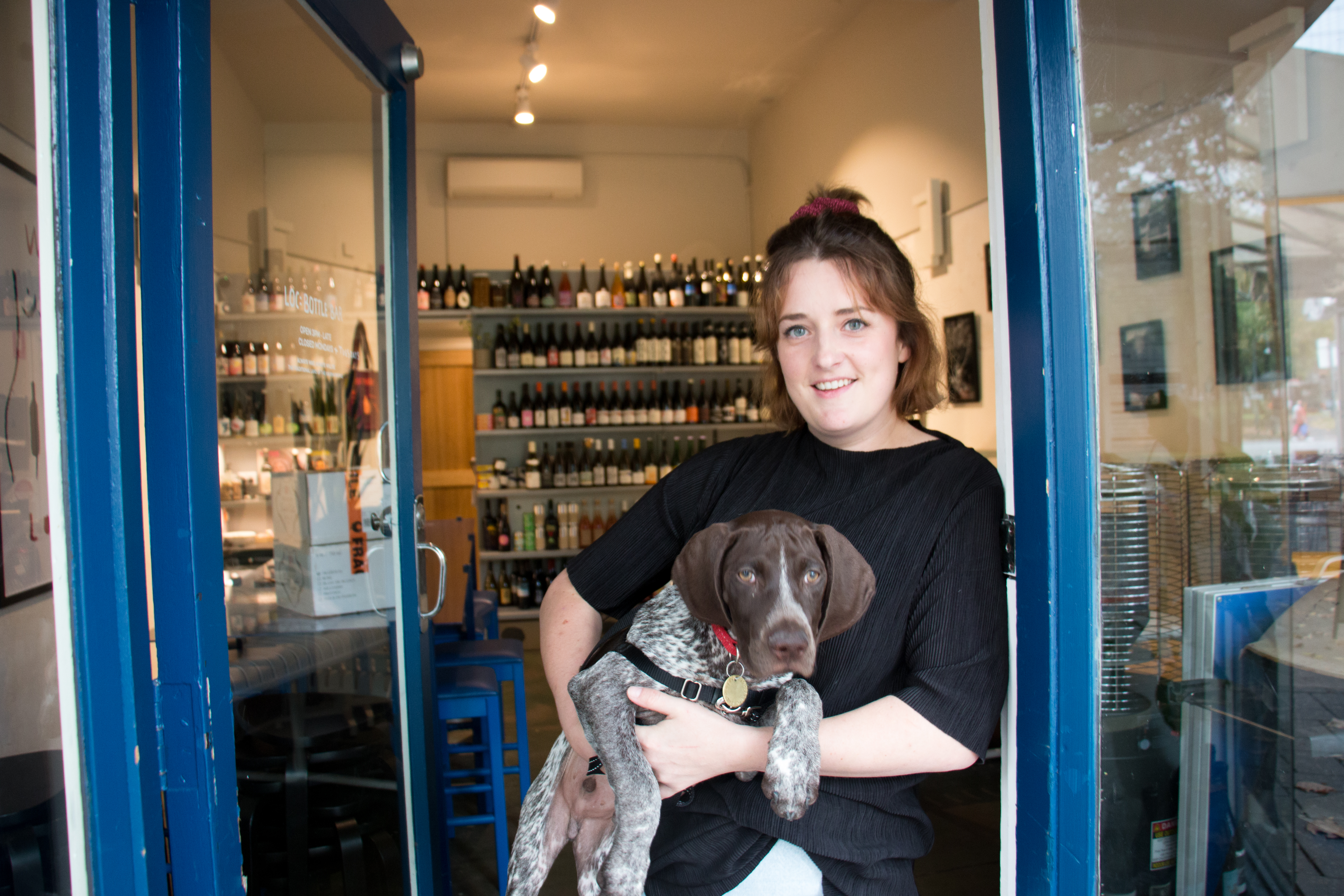
Olivia Moore and her three-month-old pup, Otto
Sucking on a purple vape, Jules explains where we stand has been “Emo [Park] for ages”.
“It was always, like, ‘Don’t go there; that’s where all the freaks hang out,” Miles adds.
“My bus stop’s there; just across the road,” Jules says. “[And] at one point I saw a bunch of people with bright-coloured hair, and that’s what drew me in.”
The attraction of alternative young people to Emo Park has caught the curiosity of LOC owner Olivia Moore. We speak with her as she takes her puppy Otto out onto the grass for “wees and poos”, navigating around the used nitrous oxide cannisters (or nangs).
“I’ve definitely tried to figure out what is it, why do they come here, and what are they doing?” Olivia says.
“I’ve only generally had positive experiences, but I don’t want to be that, like, old lady who’s asking… ‘What are you kids doing with your lives?’”
The English expat opened her natural wine bar on Mukata Hindmarsh Square in May 2020, and despite her tidy appearance and trendy tavern, she says she empathises with the rough-and-tumble kids, who have, on occasion, come in to ask for a glass of water.
While following Otto around the park, she tells us she grew up in a middle-class town called Wirral, in north-west England, where she also hung out in parks.
“Not exclusively, but we would go and that’s where different schools would go and meet up and skate and listen to music or whatever. It was relatively PG stuff,” she says.
“My memories are really fond, of 30 of us in transient groups, who didn’t go to school together, but it was a way to actually meet people.
“And why wouldn’t [you meet in] a park? It’s better than the mall. Otherwise, it was like everyone would just go to the mall on the weekend, and then that’s, I think, even more lame, because it’s just, like, spending money on trash or drinking or eating junk food.”
Back with Miles and Jules, we ask how they spend their time here. “Smoke, drink,” Miles says. Jules says they all party “without a house”, but also take photos and make crafts, such as bracelets and visual arts.
Reuben Lane co-owns pre-loved clothing shop Room on Fire, next to LOC. The shop is filled with predominantly vintage ‘90s streetwear. A large, glass cabinet filled with hats and sneakers sits in the middle of the room, which also doubles as Reuben’s desk.

Reuben Lane leafing through a rack of clothes. This picture: Johnny von Einem
From here, he looks out at Emo Park’s daily goings-on. Like Olivia, he wants to know the origins of the area, which he describes as an “Adelaide city icon” that has always been filled with alternative kids.
“Everyone knows Emo Park,” Reuben says. “But it seems to be that the old Emo Park has now transitioned into the park directly in front of our store, which is the new Emo Park.”
Reuben believes the migration from one park to the other happened around late-November, and possibly coincided with the removal of the fencing that surrounded the Pullman Hotel and the grassed area while it was a medi-hotel.
“I like to think that they’ve upgraded, or the old Emo Park is ‘been there, done that’, and they’ve just found their new niche,” he says.
Jules, who has been hanging out in Emo Park for a year and met Miles here six months ago, says the migration was actually caused by feuding subcultures.
They say it was “eshays” – another social clique, which can be identified by its members’ trademark Nike TN sneakers, bum-bags and designer clothing.
Jules says there were eshays at the original Emo Park “hate-crimeing” and “throwing stuff” at them, so they were forced out.
“We just were like, ‘No, we don’t want to be around that’ – so we moved,” they say. “I got a Mars Bar thrown at me, so I ate it.”
SA Police superintendent Matt Nairn is in charge of the city’s eastern district, and told CityMag the police were “aware” of issues involving young people in CBD hangouts – “including Emo Park/Hindmarsh Square,” he says – and they liaise with store owners and security guards regularly to report any antisocial, violent or criminal behaviour.
“Eastern District Policing teams are regularly patrolling these locations and working with traders, City Council and service providers to create a safe and enjoyable space,” he says in a statement.

For two years, Cam Desteno has worked as a sales assistant at the Grenfell Street outpost of cult music retail store Derringers. Before we speak, he fields a request from a woman wanting to buy the correct gear to sample bird sounds in the Adelaide Hills.
After sourcing the equipment, Cam tells us he’s at the shop five days a week and, from his place behind the service counter, also has an ideal vantage point of the western side of Emo Park, where the concrete thongs and skeleton sculptures are.
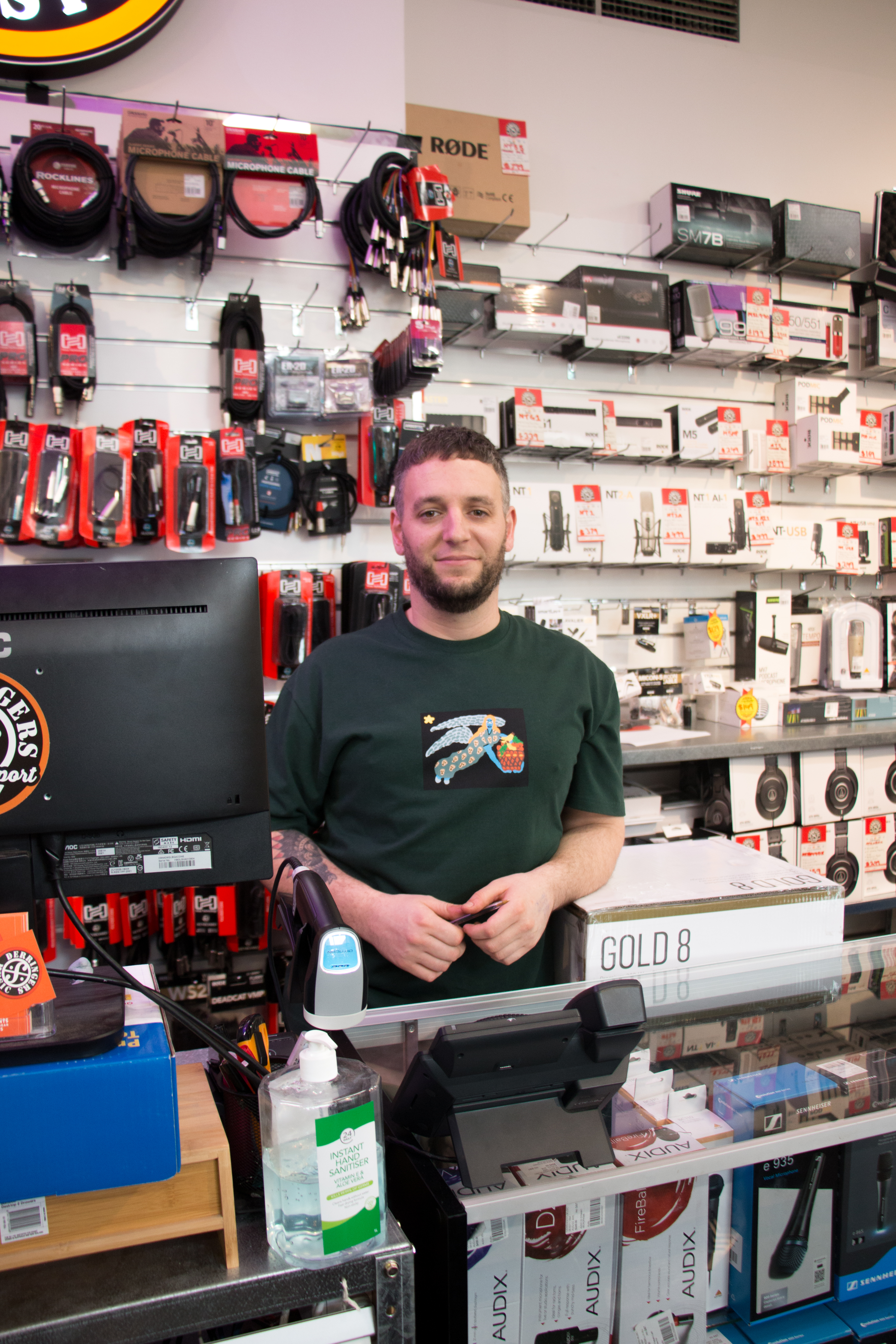
Cam Desteno behind the Derringers counter
When we ask what he’s seen, Cam seems reticent to answer. He eventually says the “open drug-use” and displays of “bad mental health” stand out to him.
“Just people yelling at the sky, or yelling at themselves… And then, I guess, you know, like, public drug use on a weekday is probably due- It’s not like that’s just a shit person,” Cam says. “Obviously, that’s, like, a problem. They’re going through something.”
Cam says the original Emo Park, out front of Derringers, isn’t what it used to be.
“I think it’s changed,” he explains. “Back in the day, there used to be, like, a lot of, like – for lack of a better word – goth kids.
“Everyone knows what that means. I don’t have to really describe it, and it shouldn’t be a bad word. I think, like, a lot of kids would wear that label with pride. I think I was a goth kid when I was a teenager, too.”
Cam agrees with Jules’ earlier comments, that the young alternative kids moved to the Pullman side of the park because this side was attracting individuals with more aggressive behaviour.
“This side here now… you see a lot of kids with ankle bracelets on, and by that I mean home-detention bracelets on,” he says.
“There’s a lot of eshay kids that hang around now. The ones that wear, like, Ralph Lauren… Tommy Hilfiger and stuff like that.”
The Commissioner for Children and Young People, Helen Connolly, says she’s aware of the kids that gather in Mukata Hindmarsh Square, and that they’ve been meeting there for “decades”.
“It’s a good spot for young people, as it’s close to transport,” she says, adding it’s “hidden” without being “secretive” and is also near shops and food outlets.
But over the last couple of years, the Commissioner has noticed an increase in the number of young people who appear “quite vulnerable and at-risk” in Emo Park’s orbit.
“In terms of their actual situation and their support needs, I’m not sure which services, if any, are providing outreach to young people at-risk in the city to determine their support needs,” Helen says.
On another day, we visit Emo Park and meet a teenager called Jasmine. She’s living in a State Government group home down south, and we’ve given her a pseudonym to protect her identity. We can’t describe her appearance, other than to say her clothing fits the emo bill.
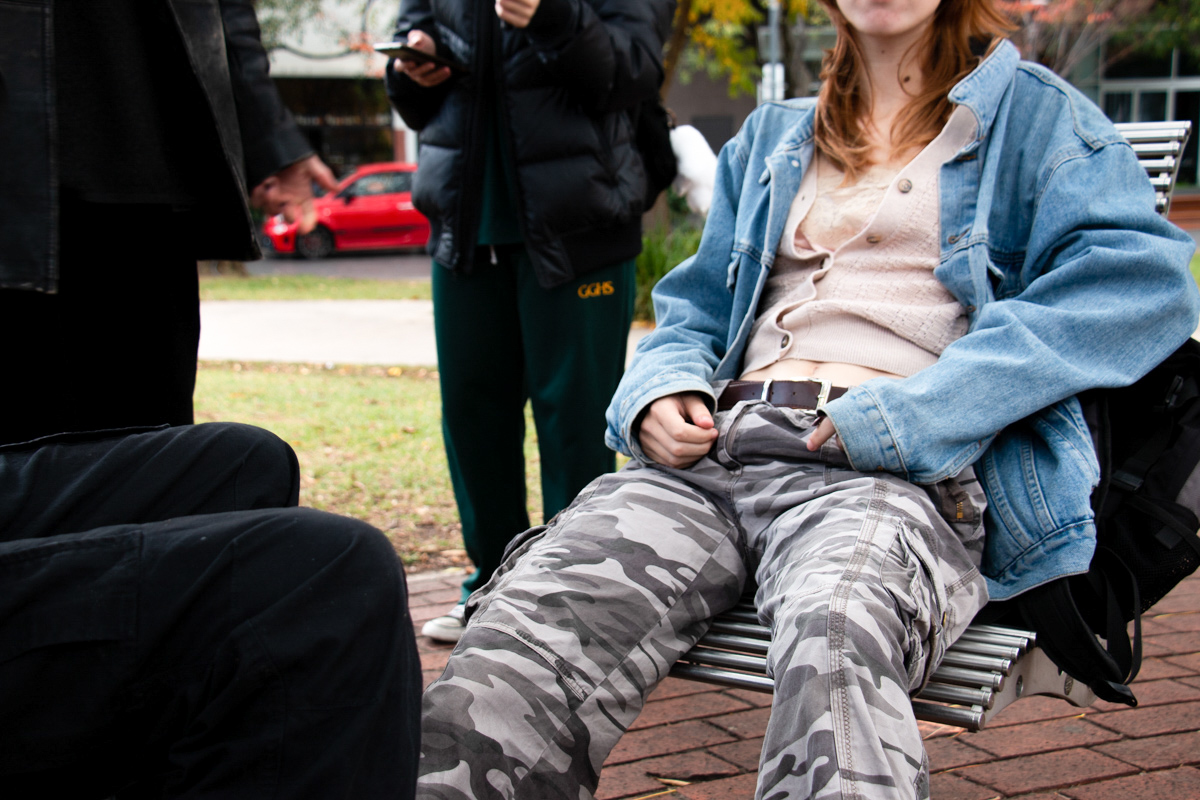
A young person who is not Jasmine
Jasmine describes where she lives as a “comforting jail” because “you have your room and that’s your only spot to get alone”.
As a person under the age of 18 who can’t hang out in licensed venues, she comes to the park, which is an easy train commute from home. Jasmine estimates she comes here every day, though she recently tested positive for COVID-19 which meant she couldn’t see her friends for a while.
“That was kind of hard, but the second I was out of isolation, I was right back here,” she says.
Jasmine believes alternative kids have been coming here for 30 years, and it doesn’t matter if governments or councils create spaces for young people – there will always be those who push back. And doing so may put some in a precarious position.
“It’s kind of like if you were not part of the straight line of what society considers normal, it will have consequences,” she says.
“Back in the day, if you were gay, you would get bashed. It’s kinda like the same, obviously, without all the extra problems.
“[It’s] part of the risk if you want to be yourself.”
While pulling on grass around her feet, she says if Emo Park didn’t exist, she would feel depressed. “I would be way more on drugs… because this is like an escape for me,” she says.
“I can come here and be happy when I’m sober. I can be sober here and not think about drugs, because I’m surrounded by people that actually make me happy.”

University of South Australia social work scholar Paula Rowe says it’s healthy for young people to gather in public, but she isn’t confident it’s totally safe.
“I wouldn’t say naively that it is completely safe, because all sorts of things go on at street level that we need to be mindful of. But [it’s] certainly important for young people’s development,” Paula says.
When we meet, the UniSA academic is wearing a leather jacket and a collection of multicoloured tattoos peek out from her sleeves.

An Emo Park veteran
Aside from specialising in social work, Paula is a metal music scholar, meaning she’s dedicated a portion of her research career to understanding the individual and community benefits of the oft-maligned genre. But her passion for resisting the norm can be traced to her upbringing.
“I was very much ostracised in my high school,” she says. “I went to a school when it was brand new, actually, the Heights [High] School. There was a really high immigration concentration there, of families coming from the UK. And I had a different birth name, a Ukrainian birth name, so my name was different, I looked different, I didn’t fit in, I didn’t listen to the British music and was picked on mercilessly.”
Much like those who gather at Emo Park, Paula found a subculture in metal that became her “crutch”. She communicated this subculture through her clothing choices, wearing all black.
“Being that kid that wore the ripples in the black jacket, and the brooding teen that spoke to no one but was super smart and kept it all inside,” she says. “That was very much my pathway.”
When Paula was 16, you could find her hanging out at Tea Tree Plaza, and as she got older (and braver) she eventually started visiting the city, bumming around train stations and under bridges. Paula and her new friends made these public places their own.
“Young people are exceptional community organizers, really – you know, bringing people together with like-minded people, with shared interests and shared purpose, social identity,” she says.
While the city does have small pockets designed for young people, such as education centre Youth Inc. on Hindley Street and Rundle Mall’s City Library, there’s a state-wide problem of young people rarely being invited to influence the creation of these spaces – or really any decisions that impact them.
“We really need to resist these persevering adult-oriented ideas around what young people need,” Paula explains.
“We’ve seen this in nearly all local government areas, where people sit around a table and go, ‘Let’s have a skatepark, let’s make it look like we’re doing something for young people’.
“By design, that’s very exclusive for a minority. It doesn’t suit a lot of young people from different cultural backgrounds with different ranges of physical capability. It’s quite gendered.”
Paula says when consultations take place, often “skilled-up” youth groups – such as student representative councils or local government youth advisory groups – are consulted, while many are left out.
“Unless they have links to the broader community, then that can become a very narrow view of what the rest of the youth demographic need,” she says.
Back on the grass of Emo Park, CityMag asks Miles and Jules what they would like from the local council to improve their city experience. Jules says straight away “more sheltered areas”, so they can hang out somewhere other than Rundle Mall when it rains.
Miles says he’s been saying “for weeks” he wants to stop hanging out in Emo Park, but he keeps getting reeled back in.
“It’s kind of a problem,” he says, laughing.
“I say to all of my friends outside of Emo, ‘I’m gonna stop hanging out there’, and then the next day I send them a Snap.”
By the time our interview wraps up, we’re joined by about five other young people, all sitting cross-legged. We turn our recorder off and chat about why they like spending time here.

One of our young friends’ “currently bawling” playlist
We discover we have a lot in common. One girl with brown hair and thick eyeliner has a “bawling” Spotify playlist filled with Billie Eilish songs, just as this reporter has a “weeping playlist” filled with Jeff Buckley and Crystal Castles tracks. Unsurprisingly, there’s a lot of overlapping, sappy singles.
A young man called Grady comes and sits with us. He’s 15 and has never been to the park before. One of his friends is moving to Melbourne and he’s come to Emo Park to “spend some time together before they leave,” he says.
Asked what he knew of Emo Park before visiting, Grady says his older siblings warned him to avoid it. But after being here for half an hour, he can now say he’s enjoying it. “I think we’re going to probably sit here for a while and then maybe go eat,” Grady says.
Paula believes there will always be a portion of young people – in the transitional phase between being adults and kids – who will always “test, flex [and] push back” against the norm. And parks are crucial places for them to experiment with this identity.
“We need that in-between space where we can rehearse our social identities, how we socialise with other people, how we form our gravitational pull with other people and have those conversations,” she says.
“For the longest time, open spaces, leisure spaces have been the space for young people to come together to do those things, to form those relationships and social bonds.
“It’s all a dress rehearsal for the rest of our lives.”
If this story raised issues for you, you can call Lifeline on 13 11 14.
If it is an emergency, call 000.
